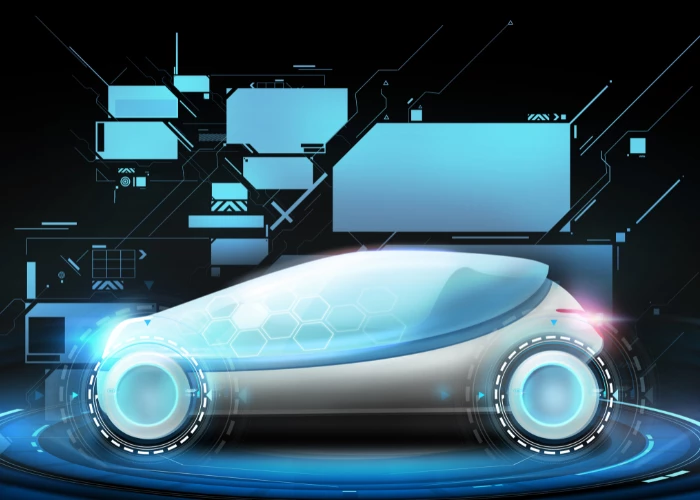Automotive IQ Guides: Connected Cars
What are the opportunities and challenges facing manufacturers in the rollout of the connected and automated vehicle?
Add bookmark
In order to perform functions independently, Level 5 autonomous cars will need to communicate with other self-driving cars and infrastructure.
What is more, they will need to do this while securely processing vast amounts of data, in real time and with low latency. To achieve this, manufacturers, in consultation with regulators, are exploring several promising technologies:
- Dedicated Short-Range Communications (DSRC)
- Cellular vehicle-to-everything (C-V2X)
- Satellite connectivity
But which technology will offer the best, most cost-effective, low-latency and scalable solution for the future? And is it even possible for a single technology to meet all the self-driving car’s connectivity demands?
Considering that the technology has to support all SAE driving levels from – 0 to 5; entirely manual to fully automated – while taking into consideration the specific needs of different regions, stakeholders, users and related business models, a single solution may not be achievable.

Furthermore, to reach its full potential, interoperability with all compliant systems and vehicle classes across brands and borders is a prerequisite. This extends to road infrastructure systems, which have to deliver seamless service quality for the entire connected fleet.
To achieve the desired level of functionality the system must support the following communication:
- Vehicle-to-vehicle (V2V) A short-range messaging system, supporting real-time safety systems that help vehicles avoid collisions
- Vehicle-to-infrastructure (V2I) Cars use V2I communication to connect with infrastructure such as road signs and traffic signals, potentially reducing congestion
- Vehicle-to-pedestrian (V2P) Using V2P communication, vehicles can alert pedestrians of potential accidents using mobile apps on smartphones or smartwatches
- Vehicle-to-cloud (V2C) To communicate with the cloud, automobiles use V2C communication to access in-vehicle services for infotainment or Over The Air (OTA) software updates, amongst others
In selecting the best-fit solution, manufacturers and regulators need to weigh up the various technologies in light of functional performance, flexibility, cost, reliability and scalability.
The battle for V2X technology supremacy rages on: DSRC versus C-V2X in the connected car
With DSRC already powering several roadside systems, such as toll collection, this was initially the technology of choice. However with the rollout of 5G, C-V2X is gaining industry support, particularly for self-driving functions that require high data rates at low latency.
With the emergence of this alternative, the industry now has to consider both options before deciding on which one to support.
Both standards would operate in 75MHz of bandwidth – from 5.850GHz to 5.925GHz in the US, and 5.855GHz to 5.925GHz in Europe.
DSRC is a variant of the IEEE standard 802.11a that was the first WiFi standard to use orthogonal frequency division multiplexing (OFDM) and the 5GHz band. The DSRC version is called 802.11p, and operates in one of seven 10MHz channels in the assigned spectrum.
C-V2X, on the other hand, became a serious contender with 3GPP Release 14. Not only does it feature enhanced cellular V2N communication, Release 14 also included standards on direct vehicle-to-vehicle (V2V) and vehicle-to-infrastructure (V2I) communication for the very first time.
What is more, C-V2X running on 5G can achieve a data rate of 10 gigabits per second (Gbps) – compared to DSRC’s 3 to 27 megabits per second (Mbps) and 4G’s theoretical 100 Mbps.
5G also has a latency that is 100 times faster than 4G, and facilitates cloud connectivity – a key enabler of V2V – while using the cellular network for V2I rather than roadside units (RSUs).
C-V2X hasn’t been as extensively tested and vetted as DSRC, trials are being stepped up as the 5G network rolls out.
The changing state of connectivity preferences for Connected Cars
Although many in the motor industry were initially reluctant to join the cellular carriers and chip companies, like Qualcomm, in lobbying for C-V2X this is rapidly changing. For instance in April 2019 Toyota announced it was halting plans to install DSRC technology on US vehicles. The company said that the decision was based on "a range of factors, including the need for greater automotive industry commitment as well as federal government support to preserve the 5.9GHz spectrum band for DSRC."
In a drive to see 5G taking its place in the connected self-driving vehicle ecosystem, a group of manufacturers have formed an advocacy organization, the 5G Automotive Association (5GAA) to promote the C-V2X agenda. With over 75 corporate members, eight or more auto manufacturers, and big technology firms like Intel and Qualcomm, this is clearly an influential body.
However to counter the C-V2X onslaught, the IEEE has formed a study group to update the 802.11p standard and improve its capabilities in V2X applications. The goal is to make it faster, provide lower latency, and give it a viable future.
Nevertheless, this may be too little too late as DSRC took another blow with the announcement by the Federal Communications Commission (FCC), in November 2019, that it intends to divert some of the vehicle vehicle-to-vehicle communication bandwidth for WiFi.
Justifying the move, FCC chairman, Ajit Pai, said of DSRC: “It is not widely deployed. And in the meantime, a wave of new transportation communication technologies has emerged. As a result, a lot of people are wondering whether this valuable spectrum – a public resource – is really being put to its best use.”
Thus the FCC proposes to make the lower 45MHz of the band available for unlicensed uses like WiFi while allocating the upper 20 MHz to Cellular Vehicle to Everything. At the same time, the commission intends to seek public input on whether to allocate the remaining 10MHz in the band to C-V2X or DSRC.
While fast cellular internet connectivity can be provided from terrestrial cell towers over short ranges, trouble arises when a connected car moves into a rural, largely unconnected environment that does not have sufficient terrestrial cellular infrastructure to guarantee an uninterrupted connection.
With self-driving vehicles relying on constant connectivity for safe operation, several companies are considering utilizing satellites to supplement 5G, LTE and 4G technologies.
Can satellites boost cellular-v2x communication, or even surpass terrestrial 5G-based C-V2X performance?
For quality of service, reliability of signal and volume of data, particularly in a broadcast scenario, satellite technology is difficult to beat.
According to US-based connectivity company Kymeta, satellite internet technology is a more stable solution than 5G or LTE for connected cars, offering faster speeds over greater ranges – albeit at a higher cost.
Unlike terrestrial 5G networks, that are prone to sporadic connectivity in rural environments, delivering the signal directly to the vehicle via satellite ensures the vehicle remains connected at all times.
However, the real benefit of satellite technology in a connected car would be the ability to switch networks seamlessly between 5G, LTE, and satellite.
The technology Kymeta uses to accomplish this seamless and uninterrupted connectivity is the same as that used in televisions, with a flat panel satellite antenna added. The core technology is a beam forming flat panel antenna, based on LCD technology that uses the pixels in the antenna to form a beam and point and track the satellite.
What is more, using algorithms to understand the best way of connecting for the type of traffic the user is demanding, the system can automatically decide what signal to use for what application, and seamlessly switch between 5G, LTE and satellite, using multiple links at once.
For instance if the cellular network is wide open and available, with good transmission speeds up and down with no packet loss and very low latency, it is possible to route the bulk of the traffic over that link.
However, the system will constantly evaluate both the satellite and cellular links to make sure they are performing as it thinks they should. As soon as a link starts degrading, or becomes congested, traffic will be moved seamlessly over to one of the other links.
As automated vehicle volumes scale up on the path toward deployment, the support for satellite technology will continue to gain momentum. The conventional wisdom is that autonomous vehicles must be designed to operate in the absence of a wireless connection – the reality is that connectivity for autonomous vehicles will likely become a regulatory requirement.
The importance of regulation, and in particular standardization, was well illustrated by the results of Automotive IQ’s Connected Cars 2020 Survey.
In replying to the question, “What do you think are the top challenges when it comes to the connected car overall,” 50 percent of respondents cited standardization of legislation as the top challenge.

But regulation is not the only item companies are calling for the standardization of in the connected car ecosystem. As is the case with automated vehicles, the industry is calling for a standardized framework that defines the levels of connectivity – similar to the SAE’s J3016, which describes the levels of automation.
It is time for the industry to define the levels of connectivity in connected cars
According to McKinsey and Company, vehicle data spun off by surging vehicle connectivity will be critical for generating revenue, reducing costs, and increasing safety, and could represent a value pool of up to $750bn by 2030. The value of this data will depend in part on the acceptance of clear-cut standards.

A common understanding and shared language will help players across the ecosystem communicate about current and emerging opportunities. It will also make it easier for consumers to compare features and capabilities of different offerings.
Thus after three years of cross-industry research, multiple global roundtables, 3,000 consumer interviews and more than 100 interviews of executives from companies ranging from start-ups to large corporations, the McKinsey Center for Future Mobility has proposed a system that it believes will bring clarity to each distinct step change in connectedness in the coming months and years.
As technology in the connected-car ecosystem becomes more sophisticated, consumer expectations will evolve in parallel, creating a need to deliver higher-value user experiences.
The C3X framework makes it easier to quantify value-creation opportunities associated with increased connectivity. Players across the entire ecosystem will be able to understand with greater precision what’s necessary to take user experience to the next level and how much value they will be able to generate through a connected vehicle across these levels.
In these early days of connectivity it is clear that the ecosystem is fluid and changing rapidly as technologies, regulation and infrastructure matures.
It is therefore important that industry professionals avail themselves of the latest information regarding connected vehicle trends. Automotive IQ offers the following events specific to the connected and self-driving car.





























